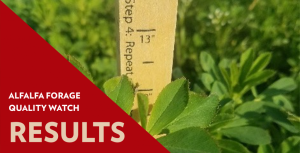 Dairy farmers and the community recognize the importance of high-quality alfalfa in dairy rations. It provides protein, energy, and minerals and increases milk production while maintaining low feed costs. One of the most important factors in determining alfalfa quality is its maturity at harvest. Also, the yield of the first cutting of alfalfa is typically the largest of the year, accounting for 25-40 percent of the year’s total crop.
Dairy farmers and the community recognize the importance of high-quality alfalfa in dairy rations. It provides protein, energy, and minerals and increases milk production while maintaining low feed costs. One of the most important factors in determining alfalfa quality is its maturity at harvest. Also, the yield of the first cutting of alfalfa is typically the largest of the year, accounting for 25-40 percent of the year’s total crop.
First cutting alfalfa is the most important and critical cutting of the alfalfa growing season. Determination of first cutting is truly based on quality-the maturity of the alfalfa plant. Cutting the plant too early, there is not enough fiber in the plant for high-producing cows. Cutting too late, fiber increases, but fiber digestibility decreases. Subsequent harvests are based on 28 days between cuttings.
To assist dairy farmers and nutritionists in determining the appropriate time to harvest 1st cutting alfalfa based on quality, Extension Regional Dairy Educator Tina Kohlman partnered with Fond du Lac County Forage Council in conducting the “Alfalfa Quality Watch” project. Each Monday for 3 weeks, Kohlman would go to 7 representative fields within the county, collecting alfalfa plants cut at chopper height and submit those samples to a lab for analysis of Relative Feed Value, protein, and fiber. In addition to the lab analysis in determining quality, PEAQ (Predictive Equation for Alfalfa Quality) readings were taken field-side to help farmers compare the heights of their alfalfa plants to the representative fields and respective lab results. Results were shared at https://fyi.extension.wisc.edu/fdlag/alfalfa/.
First cutting alfalfa sets the stage for high quality and yield of feed, reducing feed costs for the producer while maintaining inventory for quality feed.




